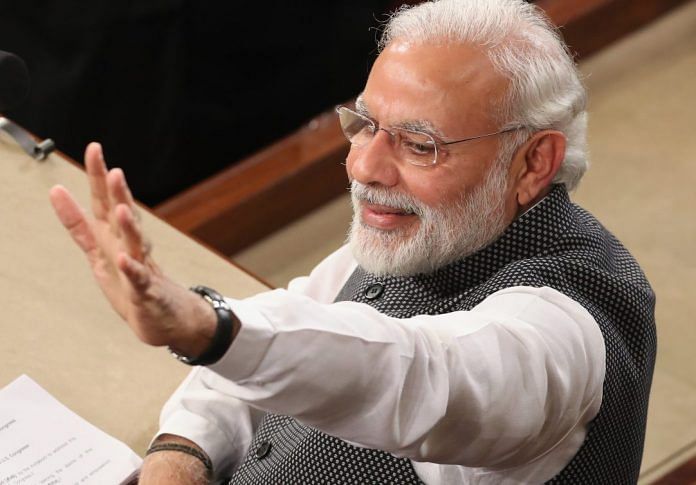Modi can’t carry out an ‘anti-incumbency’ campaign against the Congress when he is the incumbent, he needs a new strategy for 2019.
If you close your eyes and think of the one word that Narendra Modi used the most between 2013 and 2015, the answer would be vikas (development).
The Prime Minister said vikas, vikas, vikas throughout that time, thus owning the development narrative. If you want to vote for development, you will vote Modi, he suggested.
But now, Modi has lost the vikas narrative. The slogan ‘Vikas gando thayo che’ (vikas has gone mad) in the Gujarat assembly elections last year was the final nail in the coffin.
When PM Modi coined the idea of ‘New India 2022’, he was almost acknowledging he had been unable to deliver on the tall achhe din promises he had made in 2014. The Gujarat elections also showcased how farm distress and rising unemployment have overshadowed the feel-good factor around Modi.
From a clean Ganga to fibre-optic cables in every village, from 100 per cent sanitation to jobs through Make in India, there’s a lot that the Modi government hasn’t been able to deliver on. Unless voters experience a palpable change in their living conditions and future prospects, no amount of propaganda will convince them that vikas has been delivered.
Garibi
Until mid-2016, Prime Minister Modi launched one vikas-centred initiative after another, each with a big PR bang. But in November 2016, demonetisation changed the narrative from vikas to garibi (poverty).
Demonetisation was sold as a panacea to poverty — black money would disappear and voila, the rich would be poorer, and the poor richer.
Until the end of August 2017, the Prime Minister’s speeches would talk about garibi, garibi, garibi. “Garib, garibi, garibon… they are still ringing in my ears,” a BJP leader said after listening to the Prime Minister’s speech at the BJP national executive in January 2017.
It was a tried and tested political narrative, as we know from India Gandhi’s success with Garibi Hatao (remove poverty).
The best narratives are those with a clear enemy. The enemy here was obvious: those black money-hoarding, tax-evading rich people. All objections to demonetisation were answered with ‘you must have lost black money’. There were tax raids left, right and centre across the country. There were corruption cases against anyone remotely linked to the opposition.
It was obvious early on that demonetisation was a miserable failure at busting black money but the garibi narrative continued to work thanks to its anti-rich people edge. What did the garibi narrative in, eventually, was a decline in GDP figures by the end of August 2017, along with concerns over unemployment, job creation and a slowdown in the rural economy. The hasty implementation of GST made matters worse.
We stopped hearing the anti-rich people narrative. The tax raids continued but slowed down. The government started pretending demonetisation never happened.
Anti-Congressism
Bad news on the economic front made the Prime Minister attack the Congress party more and more. As early as February 2017, PM Modi made a surprisingly strong attack at his predecessor Manmohan Singh, telling him, “Bathroom mein raincoat pehen kar ke nahana, yeh kala to Doctor Saab hi jaante hain aur koi nahin jaanta hai (Only Dr Saab knows the art of bathing while wearing a raincoat in the bathroom).” Vikas seamlessly gave way to garibi but PM Modi’s keyword shift from garibi to anti-Congressism was abrupt and awkward. It was an offensive defence. The import is obvious: I may have failed, he has been suggesting, but I’m any day better than the Congress.
Congress this and Congress that. Nehru did the wrong and messed that up. Gandhi family is at the root of all evil, and so on. With such a line of attack, he has been trying to accentuate hatred and distrust towards the Congress.
The greatest point of attack is Rahul Gandhi. Until the era of vikas and garibi, the BJP’s answer to Rahul Gandhi was Smriti Irani. They wanted to make sure they do not let him even be compared to Narendra Modi. A sharp distance was created. Now the Prime Minister takes on Rahul Gandhi himself. He still doesn’t name Rahul Gandhi, but doesn’t call him “shehzada” anymore. All of his party, starting with president Amit Shah, criticise Rahul Gandhi day in and day out.
It is ironic that there’s more anti-Congressism coming from the BJP today than in the 2014 campaign, which was relatively more about vikas than attacking the house of cards that was UPA-2.
A risky strategy
Firstly, the Congress can’t be blamed when it is out of power. You can’t carry out an anti-incumbency campaign when you are the incumbent.
Secondly, the people don’t hate the Congress as much as the BJP does. As recently as 2009, India voted handsomely for the Congress.
Thirdly, the strategy can backfire. Just as it is said that Modi grew in stature with the constant attacks on him, the Congress is also growing in stature with the Modi-led BJP obsessing over it. Attacking the Gandhi family day in and day out could have the result of creating sympathy for them.
But for now, this is the Modi strategy. The Modi government’s fourth anniversary slogan is ‘48 years versus 48 months’, arguing that it has done better in 48 months than the 48 years India was directly ruled by a Nehru-Gandhi family member.
Negative campaigning works when you are in opposition. Pretending to still be in opposition even after winning election after election doesn’t work. You can’t pretend to be David when you’re Goliath.
By turning a near victory in Karnataka into a total defeat, the Modi government has worsened its already faltering narrative. Anti-Congressism won’t save it. If anything, it will backfire.
As the Modi government goes into its last year, it badly needs a new narrative to capture public imagination in 2019.




A new narrative supported by a few good achievements would be even better.